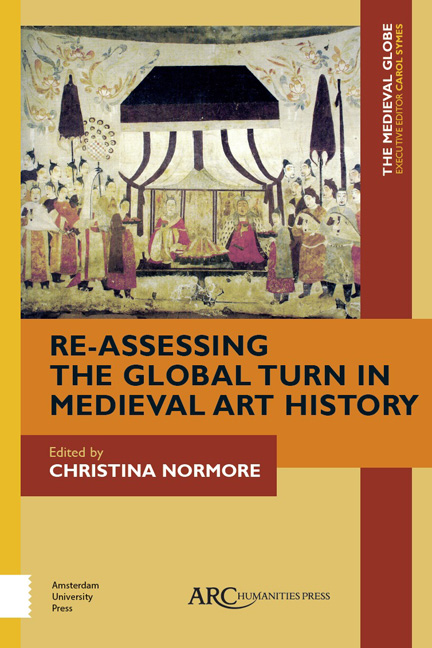Book contents
- Frontmatter
- Contents
- List of Illustrations
- Editor’s Introduction: A World within Worlds? Reassessing the Global Turn in Medieval Art History
- A Camel’s Pace: A Cautionary Global
- The Fatimid Holy City: Rebuilding Jerusalem in the Eleventh Century
- Worldliness in Byzantium and Beyond: Reassessing the Visual Networks of Barlaam and Ioasaph
- Exchange of Sacrifices: West Africa in the Medieval World of Goods
- The Beryozovo Cup: A Byzantine Object at the Crossroads of TwelfthCentury Eurasia
- Mobile Meanings: A Global Approach to a Dagger from Greater Syria
- Global Medieval at the “End of the Silk Road,” circa 756 CE: The Shōsō-in Collection in Japan
- Response: Medievalists and Early Modernists—A World Divided?
- Index
Mobile Meanings: A Global Approach to a Dagger from Greater Syria
Published online by Cambridge University Press: 23 January 2021
- Frontmatter
- Contents
- List of Illustrations
- Editor’s Introduction: A World within Worlds? Reassessing the Global Turn in Medieval Art History
- A Camel’s Pace: A Cautionary Global
- The Fatimid Holy City: Rebuilding Jerusalem in the Eleventh Century
- Worldliness in Byzantium and Beyond: Reassessing the Visual Networks of Barlaam and Ioasaph
- Exchange of Sacrifices: West Africa in the Medieval World of Goods
- The Beryozovo Cup: A Byzantine Object at the Crossroads of TwelfthCentury Eurasia
- Mobile Meanings: A Global Approach to a Dagger from Greater Syria
- Global Medieval at the “End of the Silk Road,” circa 756 CE: The Shōsō-in Collection in Japan
- Response: Medievalists and Early Modernists—A World Divided?
- Index
Summary
AT THE FURUSIYYA Art Foundation in Vaduz, Liechtenstein, a dagger arrests the beholder with its striking display of power and protection ( Plates 7.1a–b ). One's first impression is of a dazzling implement—glittering, m agnificent, and extraordinary. Just over a foot long, the dagger is crafted from silver and embellished with a profusion of engraved imagery. Closer inspection reveals a unique combination of form s: an Arabic in scription, images drawn from the Islamic princely cy cle, and an icon of a C hristian warrior saint in a p ose of victory. Scholarly consensus locates its production to the twelfthor thirteenthcentury luxury industries of Greater Syria, a region characterized by its complex mosaic of Christian and Islamic polities and notable for its extreme religious, linguistic, ethnic, and cultural diversity. The objects that emerged from t his context often exhibit a synthesis of artistic languages and values that speaks to the interdependence of Christian and Muslim communities. The Furusiyya dagger exemplifies this kind of production, particularly its depiction of a warrior saint, a figure with clear Christian associations that, nevertheless, received interfaith veneration during this period ( Figure 7.1 ).
The dagger dates to a period in which the rulers of Greater Syria vied with one another for power and prestige, routinely establishing military alliances, trade agreements, and diplomatic relations across religious divides. In the midst of very real military conflict of crusade and jihad, economic and strategic concerns often trumped religious ideologies. Rivalries between the rulers of key cities, such as Cairo and Damascus, sometimes led Ayyubid princes to ally themselves with Frankish armies on the battlefield. The alliance between alSalih Isma’il, emir of Damascus (r. 1237– 1245), and the Franks of Acre is an example of this phenomenon, resulting in the seemingly incongruous spectacle staged at the Battle of La Fourbie (17–18 October 1244), in which Muslim warriors went into battle under flags emblazoned with crosses. Conversely, Franks such as Bohemond IV of Antioch (r. 1201– 1216, 1219– 1233) established alliances with alZahir Ghazi, the Ayyubid emir of Aleppo (r. 1186– 1216), and Kaykaus I, the Seljuk sultan of Rum (r. 1211– 1220), in an effort to prevent attacks from Leo I, the Christian king of Armenian Cilicia (r. 1187– 1219). Important fortified cities changed hands frequently, a circumstance epitomized by the frontier site of Belias/ Bānyās.
- Type
- Chapter
- Information
- Re-Assessing the Global Turn in Medieval Art History , pp. 149 - 176Publisher: Amsterdam University PressPrint publication year: 2018



